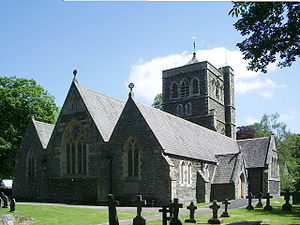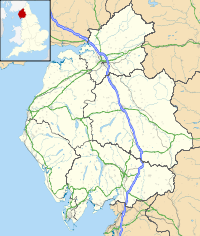- St Mary's Church, Windermere
-
St Mary's Church, Windermere 
St Mary's Church, Windermere, from the northwestLocation in Cumbria Coordinates: 54°22′51″N 2°54′37″W / 54.3809°N 2.9103°W OS grid reference SD 410 988 Location Windermere, Cumbria Country England Denomination Anglican Website St Mary, Windermere History Founder(s) Revd J. A. Addison Consecrated 1856 Architecture Status Parish church Functional status Active Heritage designation Grade II Designated 8 May 1950 Architect(s) Miles Thompson, J. S. Crowther
Paley and AustinArchitectural type Church Style Gothic Revival Groundbreaking 1847 Completed 1961 Specifications Materials Slate stone, sandstone dressings, slate roofs Administration Parish Wndermere (Applethwaite) St. Mary Deanery Windermere Archdeaconry Westmorland and Furness Diocese Carlisle Province York Clergy Vicar(s) Revd David Wilmot St Mary's Church, Windermere, is located in the town of Windermere, Cumbria, England. It is an active Anglican parish church in the deanery of Windermere, the archdeaconry of Westmorland and Furness, and the diocese of Carlisle. Its benefice is united with that of Jesus Church, Troutbeck.[1] The church has been designated by English Heritage as a Grade II listed building.[2]
Contents
History
The church originated as a proprietary chapel, built for Revd J. A. Addison from Liverpool in 1847–48. This was a simple structure, consisting of a nave, a chancel, and a south porch, with a bellcote over the chancel arch. In 1852 a south aisle, designed by Miles Thompson, was added. Revd Addison then had financial problems, and he sold the church to the town in 1855.[3] It was consecrated as a parish church during the following year.[1] Following this, a number of alterations and additions were made by the Manchester architect J. S. Crowther. In 1858 a north aisle and porch were added, followed by an extension to the west of the nave in 1861, and a north transept and vestry in 1875. In 1881–82 the Lancaster architects Paley and Austin rebuilt the east end, with a short chancel, a central tower, and a vestry and, at a later date, extended the aisles at the west end to the length of the nave, and rebuilt the south transept. By this time the only remaining parts of the original chapel were the nave roof and the south porch, which had been rebuilt outside the south aisle in 1852.[3]
Internal alterations were carried out in 1945, including the removal of an alabaster reredos.[2] A northeast vestry designed by George Pace was added in 1961. After a fire in 1988, which destroyed the nave roof, the church was restored by Michael Bottomley in the following two years. In 2005–06 the interior of the church was reordered by Paul Grout.[3] The aisles were partitioned behind glass to make separate spaces, and a corridor was built at the west end of the church to link the aisles. The south transept was converted into a refreshment area, served by a kitchen in the south aisle. A new altar and communion rails were built, and were sited beneath the central power. The pipe organ was removed and replaced by an electronic organ.[4]
Architecture
Exterior
St Mary's is constructed in slate stone with sandstone dressings and slate roofs. Its plan is cruciform, consisting of a nave, north and south aisles under separate roofs, north and south porches, north and south transepts, a chancel, two vestries, and a tower at the crossing. The tower is in three stages, with a stair turret rising to a higher level at the southeast corner. In the lowest stage, on the north and south sides, are pairs of two-light transomed windows. The middle stage contains clock faces in lozenze-shaped frames on the north and south sides, and two round-arched lancet windows in the east and west sides. In the top stage are two-light bell openings on each side, flanked by blind arches. At the top of the tower is a parapet with a quatrefoil frieze, and a small pyramidal roof.[2]
The five-light east window is in Decorated style. At the top of the east gable is a small stone cross. Along the north aisle are buttresses, two-light Geometric-style windows and a porch. The north transept has a three-light window, and an adjacent apsidal vestry. Along the south aisle are windows, some of which are lancets, the others containing plate tracery, and a gabled porch. In the south transept is blind arcading containing slit windows. At the west end of the church are three buttressed gables, each with topped by a small stone cross. The west window has four lights, and in each of the aisles is a two-light window; all have Decorated tracery.[2]
Interior
The arcades between the nave and the aisles have seven bays. The arches in the north arcade have pointed arches, and those in the south arcade have round arches. The arcades to the transepts have two bays. The south aisle contains a kitchen, a meeting room and a toilet; the north aisle has been converted in to a parish office, a reception area, and a lounge.[2] The furniture, other than the recently added altar and communion rails, was designed by Paley and Austin.[3] The choirstalls are decorated with pierced friezes, and have poppyhead finials. The wooden pulpit is polygonal, and is decorated with a frieze of pierced tracery. The font consists of a square bowl in an octagonal stem, with black marble shafts at the corners.[2] The stained glass in the east window dates from 1893, and is by Burlison and Grylls.[3] It depicts the Sermon on the Mount. There is stained glass in other windows by different designers.[5]
See also
- List of ecclesiastical works by Paley and Austin
References
- ^ a b St Mary, Windermere, Church of England, http://www.achurchnearyou.com/windermere-applethwaite-st-marys/, retrieved 14 September 2011
- ^ a b c d e f Church of St Mary, Windermere (1203319). National Heritage List for England. English Heritage. Retrieved 14 September 2011.
- ^ a b c d e Hyde, Matthew; Pevsner, Nikolaus (2010) [1967], Cumbria, The Buildings of England, New Haven and London: Yale University Press, pp. 687–689, ISBN 978-0-300-12663-1
- ^ Re-ordering at St Mary’s Church, Windermere, Paul Grout Associates, http://www.paulgroutassociates.co.uk/churches/st-marys-windermere/, retrieved 14 September 2011
- ^ Windermere - St Mary's Church, Visit Cumbria, http://www.visitcumbria.com/amb/windermere-st-marys-church.htm, retrieved 14 September 2011
Categories:- Diocese of Carlisle
- Church of England churches in Cumbria
- Grade II listed buildings in Cumbria
- Grade II listed churches
- Gothic Revival architecture in Cumbria
- 19th-century Church of England church buildings
- Paley and Austin buildings
Wikimedia Foundation. 2010.

